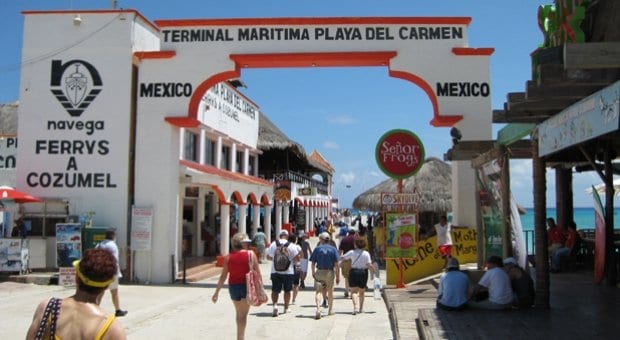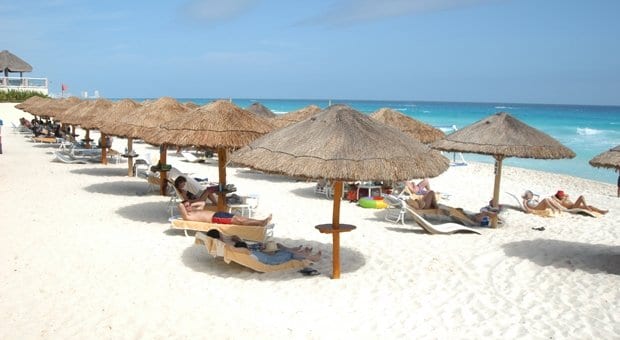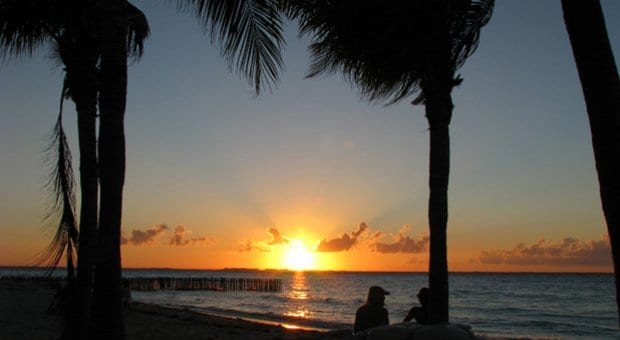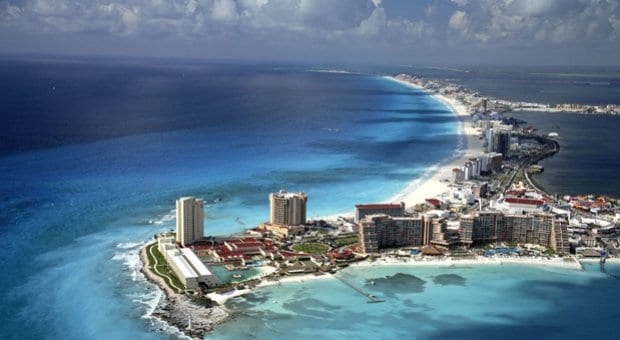
Cancun Underwater Museum features a series of sculptures by Jason deCaires Taylor off the coasts of Cancun and Isla Mujeres. Credit: Jason deCaires Taylor

Terminal at Playa del Carmen for passenger ferries to Cozumel. Señor Frog's restaurant is to the right. Credit: TampAGS / AGS Media

Shade umbrella on the beach in Cancun. Credit: Andrew Hitchcock

Ruins at Tulum, on the Mayan Riviera. Credit: Bruno Girin

Beaches near Tulum are protected for nesting sea turtles. Credit: Mindaugas Danys

Traditional Mexican souvenirs. Credit: Manfred Winslow

Sunset on Isla Mujeres beach. Credit: Manfred Winslow
For many people, mentioning Cancun evokes MTV’s spring-break specials, with hordes of drunken college kids partying as if the world were going to end. While Cancun remains a popular destination for spring breakers, its appeal has broadened as visitors have discovered it offers so much more than wet T-shirt contests and creative drinking games.
Part of the Mexican state of Quintana Roo, on the eastern part of the Yucatan Peninsula, Cancun is also the northern anchor of a 130-kilometre stretch of breathtaking coastline known as the Mayan Riviera. The name comes from the Mayan empire, which once occupied Cancun and the surrounding area. It thrived for thousands of years until Spanish colonization in the 15th century, after which the region entered a period of turmoil and decline.
The rebirth of Cancun began in the 1970s, when the area was mostly overgrown jungle and barren sand dunes. Government tourism officials had visions of transforming the region, with its beautiful white-sand beaches and turquoise waters, into a tourism mecca. Millions of dollars were invested, and now, following extensive development, the region is responsible for approximately a third of Mexico’s total tourism income.
The desire for tourism, coupled with a strong focus on hospitality, makes the region a welcoming destination for everyone — there is widespread tolerance and acceptance of LGBT people in Cancun and throughout the Mayan Riviera. Bolstering the region’s stance as an LGBT-friendly destination is a federal law that banned discrimination based on sexual orientation in 2003, with Quintana Roo also becoming the second state in Mexico to officially recognize same-sex marriages, in May 2012. Security isn’t an issue, as, unlike many parts of Mexico that have struggled with violence and high crime rates, primarily linked to drug cartels, Cancun and the Mayan Riviera have remained some of the safest parts of the country.
The two most difficult decisions to make on any trip to Quintana Roo — beyond which bathing suits to pack — are choosing where to stay and what to do.
As Cancun was the first location to be transformed under the government’s tourism plan, it’s the most developed city in the region and has the largest concentration of hotels. Its many grand, high-rise hotels are concentrated in the Hotel Zone, a 27-kilometre strip of land bordered by the Caribbean Sea on the east and the Nichupte Lagoon on the west. Almost all the hotels provide direct beach access, and five-star ratings abound, including such luxury properties as the Ritz-Carlton Cancun and the JW Marriott Cancun Spa and Resort. There are still some budget properties to be found in the Hotel Zone, but they’re in the minority, with most located in downtown Cancun, far from the beach.
Located at the southern end of the Mayan Riviera, Playa del Carmen has become almost as popular as Cancun in recent years. There has, however, been an ongoing effort to prevent over-development. Also, unlike Cancun, where visitors rarely stray from the hotel zone, Playa’s tourists can be found staying in charming boutique properties in its downtown area as well as in the larger resort properties on the outskirts of the city.
If you seek calm, secluded accommodations, Isla Mujeres — the Island of Women — is located just eight miles from Cancun, across the Bay of Women. Eight kilometres long and just under a kilometre wide, the island’s accommodations range from small resorts, such as Isla Mujeres Palace, to charming inns, like the gay-owned Casa Sirena. There is a regular ferry service to Cancun that allows for daytime excursions, but service stops at midnight, so it’s not ideal for late-night revellers — in keeping with the quiet, relaxing nature of the island.
Tulum, located south of Playa, is home to a few large resorts, but its properties are typically small, hip, eco-friendly hotels that operate using alternative-energy sources. Similarly, Puerto Morelos, located between Playa and Cancun, provides a more laid-back scene and intimate properties. Regardless of where you stay in Cancun or the Mayan Riviera, it’s easy to explore and take advantage of the entire region’s diverse offerings.
With the crystal clear waters of the Caribbean Sea and the Mesoamerican Reef, the Mayan Riviera boasts some of the best snorkelling in the world, across the entire Quintana Roo shoreline. The waters around Isla Mujeres and the island of Cozumel near Playa are also a haven for scuba divers.
Garrafon, Xplor, Xcaret and Xel-Ha are large ecological parks that offer activities such as zip lining, rafting and tours of underground rivers. Most of the eco parks and some tour operators also specialize in dolphin-swimming programs.
One of the main reasons to visit the Mayan Riviera, though, is for the Mayans themselves. Stunning ruins of the ancient Mayan cities that once dominated that region make for magical tours. Chichen Itza, a World Heritage Site and one of the “New Seven Wonders of the World,” is located about two hours west of Cancun. Coba, another large ancient Mayan city, is located about two hours west of Playa. For extra drama, the ruins of ancient Tulum sit on the edge of a cliff overlooking the Caribbean Sea.
With its spring-break roots, it should come as no surprise that Cancun also offers world-class nightlife. Large clubs like CoCo Bongo, Dady’O and Señor Frog’s bring people of all backgrounds together for outstanding music and light shows. Although not as large as those in Cancun, the nightlife spots in Playa, such as the lounge in Hotel Deseo and Tequila Barrel, can be a great night out.
Cancun and Playa also have clubs that cater to LGBT guests. In Cancun, the gay clubs are Karamba, Sexy’s and 11:11, located within walking distance of each other along Tulum Avenue in downtown. The main gay club in Playa is the beachside Playa 69. It is important to keep in mind that gay clubs typically draw their crowds on the weekends, after midnight.
Whatever your reason for visiting Cancun or one of the many places along the beautiful Mayan Riviera, you can be sure of a memorable vacation. Whether for historic sightseeing, beachside relaxation, world-class snorkelling or even spring-break debauchery, the state of Quintana Roo beckons.
For the most up-to-date travel information on gay Cancun, see our City Guide, Listings Guide, Events Guide and Activities Guide.

 Why you can trust Xtra
Why you can trust Xtra